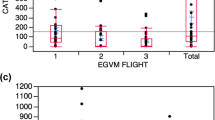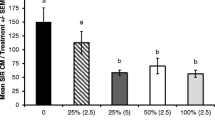Abstract
A two-year study was conducted evaluating Puffer® aerosol dispensers (Suterra LLC, Bend, OR, USA) for mating disruption of codling moth, Cydia pomonella (L.), and the oriental fruit moth, Grapholita molesta (Busck). The Puffer® dispenser consists of a pressurized metal canister loaded with pheromone active ingredients dissolved in solvent and housed within a circuit-controlled, plastic dispensing cabinet programmed to release an aerosol spray of pheromone at regular intervals. Puffers® were deployed at the label-recommended rate of 2.5 ha−1 and released ca. 5–10 mg of pheromone (depending on treatment) per 15 min during a 12-h cycle beginning each day at 15:00 h for the duration of the season. In 2005, commercially-managed apple plots (3.2–4.9 ha) were treated with Puffers® releasing both species’ pheromone simultaneously (dual-species) or with twice the number of adjacently-deployed Puffers® (4–6 m apart) releasing each individual species’ pheromones (single-species), while maintaining comparable overall release rates of pheromone between these two treatments. Plots 100 m away and not treated with pheromone served as the control. Disruption of male C. pomonella and G. molesta orientation to pheromone-baited traps was 46–75 and 91–98%, respectively, in Puffer®-treated plots compared with untreated controls. There was no statistical difference in moth disruption between plots treated with dual-species and single-species Puffers®. Fruit injury was not statistically different between Puffer®-treated plots and control plots not receiving pheromone. In 2006, disruption of male moth orientation to traps was 24–26 and 84–97% in Puffer®-treated plots (2.9–5.7 ha) for C. pomonella and G. molesta, respectively, compared with untreated controls. During this season, fruit injury was lower in pheromone-treated plots compared with untreated controls at mid-season, but not at pre-harvest. Combining the pheromone of both species into single Puffer® units did not decrease efficacy of disruption compared with deploying twice as many Puffers® releasing a similar amount of each individual species’ pheromone suggesting that multi-species disruption using Puffers® is a viable option. However, we conclude that the efficacy of disruption attained with low-densities (2.5 ha−1) of Puffers® at the moth densities recorded in this study is insufficient for effective control of C. pomonella without input of companion insecticides.
Similar content being viewed by others
References
Atanassov A, Shearer PW, Hamilton G, Polk D (2002) Development and implementation of a reduced risk peach arthropod management program in New Jersey. J Econ Entomol 95:803–812
Cardé RT, Minks AK (1995) Control of moth pests by mating disruption: successes and constraints. Annu Rev Entomol 40:559–585
Calkins CO, Faust RJ (2003) Overview of areawide programs and the program for suppression of codling moth in the western USA directed by the United States Department of Agriculture—Agricultural Research Service. Pest Manag Sci 59:601–604
Chapman PJ, Lienk SE (1971) Tortricid fauna of apple in New York (Lepidoptera: Tortricidae); including an account of apples’ occurrence in the State, especially as a naturalized plant. Special Publication March 1971, New York State Agric Exp Station, Cornell University, Geneva, NY
Chapman KL, Barrett BA (1997) Susceptibility of male codling moth (Lepidoptera: Tortricidae) to azinphosmethyl in Missouri. J Agric Entomol 14:441–447
Charlton CE, Cardé RT (1981) Comparing the effectiveness of sexual communication disruption in the oriental fruit moth (Grapholita molesta) using different combinations and dosages of its pheromone blend. J Chem Ecol 7:501–508
de Lame FM (2003) Improving mating disruption programs for the Oriental fruit moth, Grapholita molesta (Busck): efficacy of new wax-based formulations and effects of dispenser application height and density. M.S. thesis. Michigan State University, 172 pp
de Lame FM, Gut LJ (2006) Effect of monitoring trap and mating disruption dispenser application heights on captures of male Grapholita molesta (Busck; Lepidoptera: Tortricidae) in Pheromone and virgin female-baited traps. Environ Entomol 35:1058–1068
Deland JP, Judd GJR, Roitberg BD (1994) Disruption of pheromone communication in three sympatric leafroller (Lepidoptera: Tortricidae) pests of apple in British Columbia. Environ Entomol 23:1084–1090
Epstein D, Gut L, McGhee P, Haas M (2003) Evaluation of new mating disruption formulations. In: Proceedings of the 77th Annual Western Orchard Pest and Disease Management Conference, Portland, OR. 15–17 January. Washington State University, Pullman, Washington, pp 1–6
Epstein DL, Stelinski LL, Reed TR; Miller JR, Gut LJ (2006) Higher densities of distributed pheromone sources provide disruption of codling moth, (Lepidoptera: Tortricidae) superior to that of lower densities of clumped sources. J Econ Entomol 99:1327–1333
Evenden ML, Judd GJR, Borden JH (1999) Mating disruption of two sympatric, orchard-inhabiting tortricids, Choristoneura rosaceana and Pandemis limitata (Lepidoptera: Tortricidae) with pheromone components of both species’ blends. J Econ Entomol 92:380–390
Gut LJ, Stelinski LL, Thompson DR Miller JR (2004) Behavior modifying chemicals: prospects and constraints in IPM. In: Koul O, Dhaliwal GS, Cuperus G (eds) Integrated pest management: potential, constraints, and challenges. CABI Press, Wallingford, UK, pp 73–121
Il’ichev AL, Stelinski LL, Williams DG, Gut LJ (2006) Sprayable microencapsulated sex pheromone formulation for mating disruption of oriental fruit moth (Lepidoptera: Tortricidae) in Australian peach and pear orchards. J Econ Entomol 99:2048–2054
Il’ichev AL, Williams DG, Gut LJ (2007) Dual pheromone dispenser for combined control of codling moth Cydia pomonella L. and oriental fruit moth Grapholita molesta (Busck) (Lep., Tortricidae) in pears. J Appl Entomol 131:368–376
Isaacs R, Ulczynski M, Wright B, Gut LJ, Miller JR (1999) Performance of the microsprayer with application for pheromone-mediated control of insect pests. J Econ Entomol 92:1157–1164
Judd GJR, Gardiner MGT (2004) Simultaneous disruption of pheromone communication and mating in Cydia pomonella, Choristoneura rosaceana and Pandemis limitata (Lepidoptera:Tortricidae) using Isomate-CM/LR in apple orchards. J Entomol Soc B C 101:3–13
Judd GJR, Gardiner MGT, DeLury NC, Karg G (2005) Reduced sensitivity, behavioral response and attraction of male codling moths, Cydia pomonella, to their pheromone (E,E)-8,10 dodecadien-1-ol following various pre-exposure regimes. Entomol Exp Appl 114:65–78
Kanga LHB, Pree DJ, van Lier JL, Walker GM (2003) Management of insecticide resistance in Oriental fruit moth (Grapholita molesta; Lepidoptera: Tortricidae) populations from Ontario. Pest Manag Sci 59:921–927
Knight AL (2004) Managing codling moth (Lepidoptera: Tortricidae) with an internal grid of either aerosol Puffers or dispenser clusters plus border applications of individual dispensers. J Entomol Soc B C 101:69–77
Knight AL, Larsen TE (2004) Improved deposition and performance of a microencapsulated sex pheromone formulation for codling moth (Lepidoptera: Tortricidae). J Entomol Soc B C 101:109–116
Kovanci OB, Schal C, Walgenbach JF, Kennedy GG (2005) Comparison of mating disruption with pesticides for management of Oriental fruit moth (Lepidoptera: Tortricidae) in North Carolina apple orchards. J Econ Entomol 98:1248–1258
Miller JR, Gut LJ, de Lame FM, Stelinski LL (2006a) Differentiation of competitive vs. non-competitive mechanisms mediating disruption of moth sexual communication by point sources of sex pheromone: (Part 1) theory. J Chem Ecol 32:2089–2114
Miller JR, Gut LJ, de Lame FM, Stelinski LL (2006b) Differentiation of competitive vs. non-competitive mechanisms mediating disruption of moth sexual communication by point sources of sex pheromone: (Part 2) case studies. J Chem Ecol 32:2115–2143
Myers CT, Hull LA, Krawczyk G (2006) Seasonal and cultivar associated variation in oviposition preference of Oriental fruit moth (Lepidoptera: Tortricidae) adults and feeding behavior of neonate larvae in apples. J Econ Entomol 99:349–358
Palaniswamy P, Robs RJ, Seebrook WD, Lonergan GC, Weisner CJ, Tan SH, Silk PJ (1982) Mating suppression of caged spruce budworm (Lepidoptera: Tortricidae) moths in different pheromone atmospheres and high population densities. J Econ Entomol 75:989–993
Pree DJ, Trimble RM, Whitty KJ, Vickers PM (1994) Control of oriental fruit moth by mating disruption using sex pheromone in the Niagara Peninsula, Ontario. Can Entomol 126:1287–1299
Pree DJ, Whitty KJ, Van Driel L, Walker GM (1998) Resistance to insecticides in oriental fruit moth populations (Grapholita molesta) from the Niagra Penninsula of Ontario. Can Entomol 130:245–256
Reuveny H, Cohen E (2004) Resistance of the codling moth Cydia pomonella (L.) (Lep., Tortricidae) to pesticides in Israel. J Appl Entomol 128:645–651
Rice RE, Kirsch P (1990) Mating disruption of oriental fruit moth in the United States. In: Ridgway RL, Silverstein RM, Inscoe MN (eds) Behavior-modifying chemicals for insect management. Marcel Dekker, New York, pp 193–211
Rothschild GLH, Vickers RA (1991) Biology, ecology and control of the Oriental fruit moth. In: Van Der Geest LPS, Evenhuis HH (eds) Tortricid pests: their biology, natural enemies and control. Elsevier Science Publishers BV, New York, pp 389–412
SAS Institute (2000) SAS/STAT user’s guide, version 6, 4th edn., vol 1. SAS Institute, Cary
Shorey HH, Gerber RG (1996a) Use of puffers for disruption of sex pheromone communication of codling moths (Lepidoptera: Tortricidae) in walnut orchards. Environ Entomol 25:1398–1400
Shorey HH, Gerber RG (1996b) Disruption of pheromone communication through the use of puffers for control of beet armyworm (Lepidoptera: Noctuidae) in tomatoes. Environ Entomol 25:1401–1405
Shorey HH, Gerber RG (1996c) Use of puffers for disruption of sex pheromone communication among navel orangeworm moths (Lepidoptera: Pyralidae) in almonds, pistachios, and walnuts. Environ Entomol 25:1154–1157
Shorey HH, Sisk CB, Gerber RG (1996) Widely separated pheromone release sites for disruption of sex pheromone communication in two species of Lepidoptera. Environ Entomol 25:446–451
Stelinski LL, Gut LJ, Mallinger RE, Epstein DL, Reed TP, Miller JR (2005a) Small plot trials documenting effective mating disruption of Oriental fruit Moth by using high densities of wax-drop pheromone dispensers. J Econ Entomol 98:1267–1274
Stelinski LL, Gut LJ, Miller JR (2005b) Occurrence and duration of long-lasting peripheral adaptation among males of three species of economically important tortricid moths. Ann Entomol Soc Am 98:580–586
Stelinski LL, Gut LJ, Miller JR (2006) Orientational behaviors and EAG responses of male codling moth after exposure to synthetic sex pheromone from various dispensers. J Chem Ecol 32:1527–1538
Suckling DM, Karg G, Bradley SJ, Howard CR (1994) Field electro-antennogram and behavioral responses of Epiphyas postvittana under low pheromone and inhibitor concentration. J Agric Entomol 87:1477–1487
Suckling DM, Daly JM, Chen X, Karg G (2007) Field electroantennogram and trap assessments of aerosol pheromone dispensers for disrupting mating in Epiphyas postvittana. Pest Manag Sci 63:202–209
Swenson DW Weatherston I (1989) Hollow-fiber controlled-release systems. In: Jutsum AR, Gordon RFS (eds) Insect pheromones in plant protection. Wiley, Chichester, pp 173–197
Thomson DR, Gut LJ, Jenkins JW (1999) Pheromones for insect control: strategies and successes. In: Hall FR, Menn JJ (eds) Biopesticides: use and delivery. Humana Press, Totowa, pp 385–412
Trimble RM, Pree DJ, Carter NJ (2001) Integrated control of oriental fruit moth (Lepidoptera: Tortricidae) in peach orchards using insecticide and mating disruption. J Econ Entomol 94:276–285
Trimble RM, Pree DJ, Barszcz ES, Carter NJ (2004) Comparison of a sprayable pheromone formulation and two hand-applied pheromone dispensers for use in the integrated control of Oriental fruit moth (Lepidoptera: Tortricidae). J Econ Entomol 97:482–489
Vickers RA (1990) Oriental fruit moth in Australia and Canada. In: Ridgway RL, Silverstein RM, Inscoe MN (eds) Behavior-modifying chemicals for insect management. Marcel Dekker, Inc., New York, pp 183–192
Vickers RA, Rothschild GLH (1991) Use of sex pheromones for control of codling moth. In: Van Der Geest LPS, Evenhuis HH (eds) Tortricid pests: their biology, natural enemies and control. Elsevier Science Publishers BV, New York, pp 339–354
Walker KR, Welter SC (2001) Potential for outbreaks of leafrollers (Lepidoptera: Tortricidae) in California apple orchards using mating disruption for codling moth suppression. J Econ Entomol 94:373–380
Acknowledgments
We thank Lech K. Stelinski for help with deploying Puffers® and monitoring traps in the field. We acknowledge Suterra LLC for providing Puffers® and funding to conduct this evaluation.
Author information
Authors and Affiliations
Corresponding author
Rights and permissions
About this article
Cite this article
Stelinski, L.L., Gut, L.J., Haas, M. et al. Evaluation of aerosol devices for simultaneous disruption of sex pheromone communication in Cydia pomonella and Grapholita molesta (Lepidoptera: Tortricidae). J Pest Sci 80, 225–233 (2007). https://doi.org/10.1007/s10340-007-0176-7
Received:
Revised:
Accepted:
Published:
Issue Date:
DOI: https://doi.org/10.1007/s10340-007-0176-7




